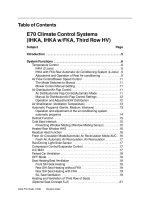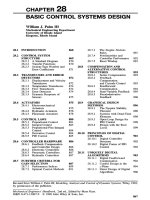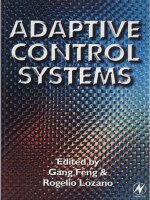Industrial Control Systems Totally Integrated Automation
Bạn đang xem bản rút gọn của tài liệu. Xem và tải ngay bản đầy đủ của tài liệu tại đây (755.35 KB, 58 trang )
Industrial Control Systems
Totally Integrated Automation
Overview of Industrial Control Systems
Industrial control system (ICS) is a
general term that encompasses several
types of control systems, including
supervisory control and data acquisition
(SCADA) systems, distributed control
systems (DCS), and other smaller control
system configurations such as skidmounted Programmable Logic Controllers
(PLC) often found in the industrial sectors
and critical infrastructures.
ICSs are typically used in industries such
as electrical, water, oil and gas, chemical,
transportation, pharmaceutical, pulp and
paper, food and beverage, and discrete
manufacturing (e.g., automotive,
aerospace, and durable goods.)
Supervisory Control and Data Acquisition consultant training Course
00_Getting Start
Industrial Control Systems
Totally Integrated Automation
Overview of SCADA , DCS and PLCs
SCADA systems are highly distributed systems
used to control geographically dispersed assets,
often scattered over thousands of square
kilometers, where centralized data acquisition and
control are critical to system operation. They are
used in distribution systems such as water
distribution and wastewater collection systems, oil
and gas pipelines, electrical power grids, and
railway transportation systems. A SCADA control
center performs centralized monitoring and control
for field sites over long-distance communications
networks, including monitoring alarms and
processing status data. Based on information
received from remote stations, automated or
operator-driven supervisory commands can be
pushed to remote station control devices, which
are often referred to as field devices. Field devices
control local operations such as opening and
closing valves and breakers, collecting data from
sensor systems, and monitoring the local
environment for alarm conditions.
Supervisory Control and Data Acquisition consultant training Course
00_Getting Start
Industrial Control Systems
Totally Integrated Automation
Overview of SCADA , DCS and PLCs
DCSs are used to control industrial processes
such as electric power generation, oil and gas
refineries, water and wastewater treatment, and
chemical, food, and automotive production. DCSs
are integrated as a control architecture containing
a supervisory level of control overseeing multiple,
integrated sub-systems that are responsible for
controlling the details of a localized process.
Product and process control are usually achieved
by deploying feed back or feed forward control
loops whereby key product and/or process
conditions are automatically maintained around a
desired set point. To accomplish the desired
product and/or process tolerance around a
specified set point, specific programmable
controllers (PLC) are employed in the field and
proportional, integral, and/or differential settings on
the PLC are tuned to provide the desired tolerance
as well as the rate of self-correction during process
upsets. DCSs are used extensively in processbased industries.
Supervisory Control and Data Acquisition consultant training Course
00_Getting Start
Industrial Control Systems
Totally Integrated Automation
Overview of SCADA , DCS and PLCs
PLCs are computer-based solid-state devices
that control industrial equipment and processes.
While PLCs are control system components used
throughout SCADA and DCS systems, they are
often the primary components in smaller control
system configurations used to provide regulatory
control of discrete processes such as automobile
assembly lines and power plant soot blower
controls. PLCs are used extensively in almost all
industrial processes.
Continuous Manufacturing Processes. These
processes run continuously, often with transitions to
make different grades of a product. Typical continuous
manufacturing processes include fuel or steam flow in a
power plant, petroleum in a refinery, and distillation in a
chemical plant.
Batch Manufacturing Processes. These processes
have distinct processing steps, conducted on a quantity
of material. There is a distinct start and end step to a
batch process with the possibility of brief steady state
operations during intermediate steps.
Supervisory Control and Data Acquisition consultant training Course
00_Getting Start
Industrial Control Systems
Totally Integrated Automation
ICS Operation
Supervisory Control and Data Acquisition consultant training Course
00_Getting Start
Industrial Control Systems
Totally Integrated Automation
ICS Operation
Integrated
Solutions
For
your
Process.
Key Components
Control Loop. A control loop consists of sensors for measurement, controller hardware such as
PLCs, actuators such as control valves, breakers, switches and motors, and the communication of
variables. Controlled variables are transmitted to the controller from the sensors. The controller
interprets the signals and generates corresponding manipulated variables, based on set points,
which it transmits to the actuators. Process changes from disturbances result in new sensor
signals, identifying the state of the process, to again be transmitted to the controller.
Human-Machine Interface (HMI). Operators and engineers use HMIs to configure set points, control
algorithms, and adjust and establish parameters in the controller. The HMI also displays process
status information and historical information.
Remote Diagnostics and Maintenance Utilities. Diagnostics and maintenance utilities are used to
prevent, identify and recover from failures.
Supervisory Control and Data Acquisition consultant training Course
00_Getting Start
Industrial Control Systems
Totally Integrated Automation
Control Components
Integrated Solutions
For
your
Process.
Key Components
Control Server. The control server hosts the DCS or PLC supervisory control software that is
designed to communicate with lower-level control devices. The control server accesses
subordinate control modules over an ICS network.
SCADA Server or Master Terminal Unit (MTU). The SCADA Server is the device that acts as the
master in a SCADA system. Remote terminal units and PLC devices (as described below) located
at remote field sites usually act as slaves.
Remote Terminal Unit (RTU). The RTU, also called a remote telemetry unit, is special purpose data
acquisition and control unit designed to support SCADA remote stations. RTUs are field devices
often equipped with wireless radio interfaces to support remote situations where wire-based
communications are unavailable. Sometimes PLCs are implemented as field devices to serve as
RTUs; in this case, the PLC is often referred to as an RTU.
Programmable Logic Controller (PLC). The PLC is a small industrial computer originally designed
to perform the logic functions executed by electrical hardware (relays, drum switches, and
mechanical timer/counters). PLCs have evolved into controllers with the capability of controlling
complex processes, and they are used substantially in SCADA systems and DCSs. Other
controllers used at the field level are process controllers and RTUs; they provide the same control
as PLCs but are designed for specific control applications. In SCADA environments, PLCs are
often used as field devices because they are more economical, versatile, flexible, and configurable
than special-purpose RTUs.
Supervisory Control and Data Acquisition consultant training Course
00_Getting Start
Industrial Control Systems
Totally Integrated Automation
Control Components
Integrated Solutions
For
your
Process.
Key Components
Intelligent Electronic Devices (IED). An IED is a "smart" sensor/actuator containing the intelligence
required to acquire data, communicate to other devices, and perform local processing and control.
An IED could combine an analog input sensor, analog output, low-level control capabilities, a
communication system, and program memory in one device. The use of IEDs in SCADA and DCS
systems allows for automatic control at the local level.
Human-Machine Interface (HMI). The HMI is software and hardware that allows human operators to
monitor the state of a process under control, modify control settings to change the control
objective, and manually override automatic control operations in the event of an emergency. The
HMI also allows a control engineer or operator to configure set points or control algorithms and
parameters in the controller. The HMI also displays process status information, historical
information, reports, and other information to operators, administrators, managers, business
partners, and other authorized users. The location, platform, and interface may vary a great deal.
For example, an HMI could be a dedicated platform in the control center, a laptop on a wireless
LAN, or a browser on any system connected to the Internet.
Data Historian. The data historian is a centralized database for logging all process information within
an ICS. Information stored in this database can be accessed to support various analyses, from
statistical process control to enterprise level planning.
Supervisory Control and Data Acquisition consultant training Course
00_Getting Start
Industrial Control Systems
Totally Integrated Automation
Network Components
Integrated Solutions
For
your
Process.
Key Components
There are different network characteristics for each layer within a control system hierarchy. Network
topologies across different ICS implementations vary with modern systems using Internet-based IT
and enterprise integration strategies. Control networks have merged with corporate networks to
allow engineers to monitor and control systems from outside of the control system network. The
connection may also allow enterprise-level decision-makers to obtain access to process data. The
following is a list of the major components of an ICS network, regardless of the network topologies
in use:
Fieldbus Network. The fieldbus network links sensors and other devices to a PLC or other
controller. Use of fieldbus technologies eliminates the need for point-to-point wiring between the
controller and each device. The sensors communicate with the fieldbus controller using a specific
protocol. The messages sent between the sensors and the controller uniquely identify each of the
sensors.
Control Network. The control network connects the supervisory control level to lower-level control
modules.
Communications Routers. A router is a communications device that transfers messages between
two networks. Common uses for routers include connecting a LAN to a WAN, and connecting
MTUs and RTUs to a long-distance network medium for SCADA communication.
Supervisory Control and Data Acquisition consultant training Course
00_Getting Start
Industrial Control Systems
Totally Integrated Automation
Network Components
Integrated Solutions
For
your
Process.
Key Components
Firewall. A firewall protects devices on a network by monitoring and controlling communication
packets using predefined filtering policies. Firewalls are also useful in managing ICS network
segregation strategies.
Modems. A modem is a device used to convert between serial digital data and a signal suitable for
transmission over a telephone line to allow devices to communicate. Modems are often used in
SCADA systems to enable long-distance serial communications between MTUs and remote field
devices. They are also used in both SCADA systems, DCSs and PLCs for gaining remote access
for operational functions such as entering command or modifying parameters, and diagnostic
purposes.
Remote Access Points. Remote access points are distinct devices, areas and locations of a control
network for remotely configuring control systems and accessing process data. Examples include
using a personal digital assistant (PDA) to access data over a LAN through a wireless access
point, and using a laptop and modem connection to remotely access an ICS system.
Supervisory Control and Data Acquisition consultant training Course
00_Getting Start
SCADA
Fundamentals principles of modern SCADA Systems
Integrated Solutions For
your Process.
Supervisory Control and Data Acquisition consultant training Course
00_Getting Start
SCADA
Fundamentals principles of modern SCADA Systems
Integrated Solutions For
your Process.
Advantages of SCADA System
ThereThe
characteristicsafor
withinofadata control system hierarchy. Network
• arecomputernetwork
different can record
and store veryeach
largelayer
amount
• The across
be displayed
in any way the vary requires
with modern systems using Internet-based IT and
topologiesdata
candifferent
ICS implementationsuser
enterprise integrationsensors overControl networks be connectedwiththe system networks to allow • Thousands of
strategies. a wide area can have merged to corporate
engineers
operator
can
incorporate
real datafrom
simulations
Many
types of
data
can
collected
to RTUsinto control system network. The connection • The to monitor
of
theThe
can be
viewed
fromofnetwork,
regardlesson site network topologies in use: • major components of
and
controldata
systems
from
outside
the the system
an
ICS anywhere,
not just of the
may•also
allow enterprise-levelbedecision-makerstheobtain
access to process data. The following is a list
Fieldbus Network. The fieldbus network links sensors and other devices to a PLC or other
controller. Use of fieldbus technologies eliminates the need for point-to-point wiring between the
controller and each device. The sensors communicate with the fieldbus controller using a specific
protocol. The messages sent between the sensors and the controller uniquely identify each of the
sensors.
Disadvantages of SCADA System
Control Network. The control network connects the supervisory control level to lower-level control
The disadvantages are:
modules.
• The system is more complicated than the sensor to panel type
• Different operating skills are required, such as system analysts and programmer
Communications Routers. A router is a communications device that transfers messages between
• With thousands of sensors there is still a lot of wire to deal with
two networks. Common uses for routers include connecting a LAN to a WAN, and connecting MTUs
• The operator can see only as far as the PLC
Supervisory Control and Data Acquisition consultant training Course
and RTUs to a long-distance network medium for SCADA communication.
00_Getting Start









